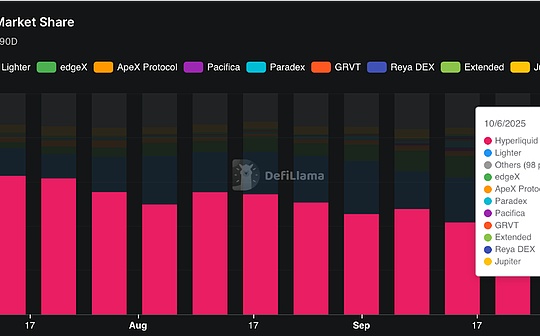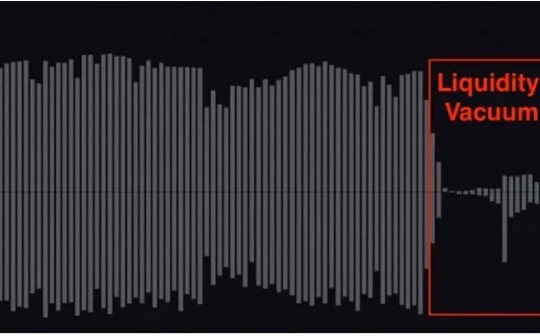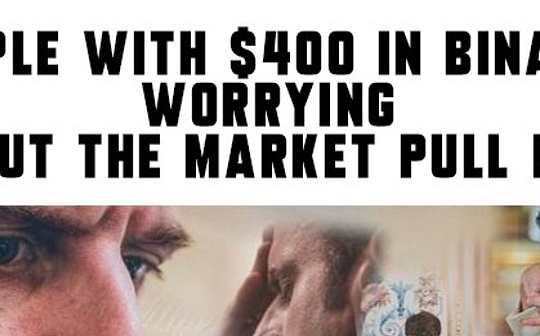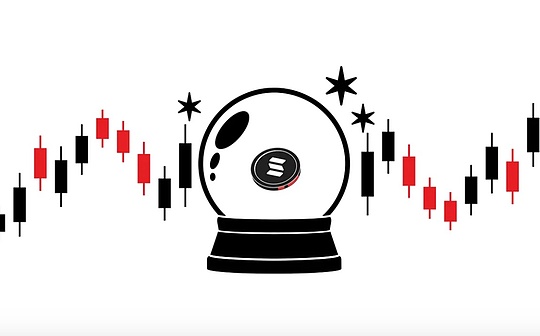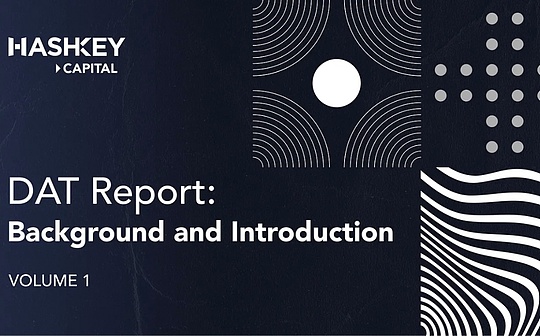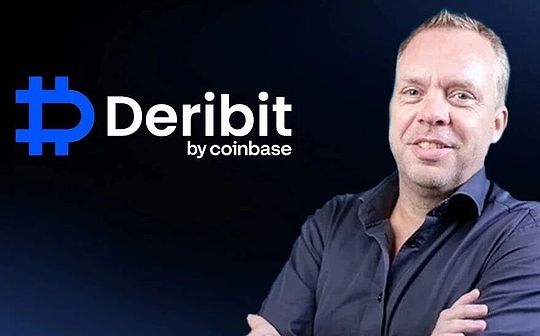
In this interview conducted by Wu Shuo, Deribit CEO Luuk Strijers shares the company’s journey from a niche platform focused on crypto options to an institutional trading leader.Deribit is currently the largest cryptocurrency options exchange. Its BTC options trading volume accounts for more than 80% of the total market trading volume, and its ETH options trading volume accounts for more than 90% of the total market trading volume.
Luuk pointed to Deribit’s early entry, consistent product focus, and infrastructure advantages as the keys to defeating multi-product competitors such as Binance.Luuk elaborated on the reasons behind the Coinbase acquisition, including strategic alignment and synergies from global expansion.He also responded to challenges regarding compliance processes, especially KYC, and emphasized that the platform will still focus on serving professional institutional investors.
In addition, Luuk also talked about his views on the DeFi options platform, future market expansion plans, product evolution directions (including the launch of options products with smaller contract units and longer maturities), and Deribit’s role and positioning as the core component of Coinbase’s international options business.
Luuk’s personal background and opportunity to enter the crypto industry
Maodi: Good afternoon, Luuk.Thank you for taking the time to speak with us.We have been paying attention to the development of Deribit for some time, and we are very happy to have an in-depth communication with you today.First of all, could you please briefly introduce your personal background and professional experience?What was your career path before joining Deribit?What was the opportunity for you to enter the encryption industry?
Luuk: Thank you for the invitation.First, let’s talk about why I got into the crypto industry — I joined Deribit in 2019 as Chief Commercial Officer.Before that, I worked at the Singapore Exchange for about five years.Going back further, I worked at a Dutch options exchange for five or six years.My earliest professional experience was in the capital market in Amsterdam, where I worked for about five years. This was my first job in 2004.It has been 21 years now, of which about 15 to 16 years have been spent doing exchange-related work.
I have been following traditional exchanges, options trading, and futures trading for almost fifteen years.When the crypto craze started, around 2016-2017, I was doing some spot trading as well.That’s when I realized there was huge opportunity and potential in this area and I really wanted to explore it further.It was this thought that finally brought me to Deribit.I officially joined in September 2019 and have been CEO for almost two years now.
Why Deribit is ahead of other major exchanges in the options market
Maodi: Deribit is a rather special exchange. It is not founded by a Chinese team like many other platforms.In your opinion, why has Deribit survived and succeeded in this space?We know that many exchanges like Binance, Bybit, OKX, etc. have also tried to launch options products, but have never been able to grab market share from Deribit.I find it interesting that they have done almost everything except breakout in crypto options.Why do you think this is?
Luuk: I think there are several reasons.We launched in 2016, which was very early.At the time, virtually no one cared about crypto options.Bitcoin was much more volatile then than it is now, so option premiums were also very high.At that time, there were no market makers specializing in options, so the quality of the order book was relatively poor.
But over time, the market grew.By 2018, we saw professional market makers begin to enter the market, and some teams were spun off from traditional large options market-making institutions and established trading teams specifically for crypto options.As they joined, the bid-ask spread became smaller and smaller, the order book depth became better and better, and we gradually established a good reputation.The first batch of hedge funds and small and medium-sized institutions began to enter the market, and we grew up little by little.This “first-mover advantage” still helps us tremendously today.Many users choose Deribit because we are the first serious players to focus on options, and we have always maintained a high degree of investment in this track.
Everything we do revolves around options.All of our resources — including the team, infrastructure — are focused on options trading.For example, instead of using cloud services, we deploy dedicated hardware ourselves, which makes our trades execute faster.We also offer functionality like multicast, an ultra-low latency binary data streaming service that no other platform is currently as fast as.We also have market-making protection mechanisms and a bunch of other features that others haven’t developed because they don’t need them—their product range is too broad.
You can think of those big platforms as “crypto supermarkets”. They do everything: spot, contracts, Token, NFT… Product managers compete for resources every day: develop spot today, develop perpetual contracts tomorrow, and occasionally options.
And for us, it’s always options.No matter it is today, tomorrow or the day after tomorrow, we always focus only on options.
This focused mindset gives us an edge and allows us to build a high-quality product.We do everything we can to ensure this product is of high quality, and that’s what makes us unique.Of course, I’m not saying that other platforms haven’t done a good job. Some platforms have indeed done a great job, but we deliberately chose to take the vertical route.We gave up some businesses. For example, we did not expand the spot market, but we did our best in options.
Product depth, liquidity or institutional trust?What drives Deribit’s market leadership
Maodi: Do you think Deribit’s leading position in the crypto options field comes more from the depth of the product, market liquidity, or the trust of institutions and professional traders?
Luuk: As I mentioned before, our core strength actually comes from our mentality of building high-quality products.This includes introducing top market makers, designing effective incentive mechanisms, ensuring that the market has sufficient liquidity, and providing some functions such as market making protection.We have been working hard to compress bid-ask spreads and maintain order book depth and quality.
But we do much more than just the transactional level.We also have advantages at the compliance and operational levels.We are regulated in multiple jurisdictions and our platform architecture is designed specifically for institutional users.For example, we have SOC 2 Type II certification, which signifies that our operational security system has been audited and verified.We also have certifications such as ISO and meet compliance standards across multiple industries.I believe that many of the other exchanges you mentioned have not done financial audits, but we have done audits for five consecutive years.
These quality indicators set us apart from the competition.Especially after the FTX crash, the market’s focus on “quality” has never been more important.Investors are starting to really compare platforms. If you are going to put $100 million in assets on a certain platform, you must make sure it is safe, reliable, and professionally operated.It is for this reason that many people choose us.
Indeed, we may have lost a little share in retail users or in some simpler products.But on the institutional side, our growth has been very significant.About 85% of the trading volume on our platform currently comes from institutional investors, and I think that will continue to be the case.Because we provide a highly professional product, we attract professional users who really know their stuff.
If you come from the traditional financial field and now want to start an asset management institution, brokerage or other crypto-oriented financial business, then what you are most familiar with and want to trade is still what you have been doing for decades – options and futures.You may be asking: “Who is the best at this?” And the answer is us.Institutional clients are looking for quality and liquidity, and that’s what we excel at.
Acquired by Coinbase: Why Deribit chose to sell and future collaborative development
Maodi: We know that Coinbase acquired Deribit this year.Besides Coinbase, are there any other potential buyers?I heard Binance, Bybit, and GSR have also expressed interest.Can you reveal more information?Why did Deribit make this decision?What is the core motivation?Why not choose to remain independent?From a strategic perspective, what changes should Deribit users expect following the merger with Coinbase?
Luuk: There are many layers to this question.Let me start from the beginning.Our founders initially wanted to cash out some of their shares, so we brought in an investment bank, Deloitte, and other advisors to help us facilitate the process.
But over time, market conditions have changed, in part due to political factors such as Trump’s election.So what started out as a plan to sell only a portion of the shares gradually turned into an interest in selling the entire company.There are indeed multiple potential buyers, including some of the ones you mentioned.But I can’t confirm who it is because we signed a non-disclosure agreement, but suffice it to say, there are other options.
So why did we end up choosing Coinbase?First, Coinbase is a publicly traded company, which makes the trading process simpler and more transparent.They can pay with shares that have a clear present value—not a vague promise of the future, but real liquidity that can be realized now.
But perhaps more importantly, we share the same philosophy.Coinbase itself has a great set of products and dominates the spot trading market.The way they build their products is quality-oriented—no shortcuts are taken, compliance is a priority, and they are financially sound.They want to expand globally, and so do we.
Deribit’s product itself is very strong, but it is a “niche” product and we are not a “one-stop supermarket” trading platform.Coinbase’s product line is more comprehensive.When the two are combined, we can provide a complete product architecture that can impact the industry’s leading players in terms of quality and breadth.At the same time, we can also start to serve some user groups that were previously unreachable, such as the retail market.
So when you combine Coinbase’s brand, trust, compliance credentials and financial strength with Deribit’s expertise in options, you have a very powerful combination.This is also the main reason why we finally chose Coinbase—of course, financial factors are also an important part of it.
Will KYC be more complicated after Coinbase acquisition?How Deribit responds to user compliance complaints
Maodi: This next question might be a bit tricky.We have seen many users complain that Deribit’s KYC process is too complicated and can even be said to be “painful”.How do you respond to these criticisms?Will KYC and compliance become more stringent after the Coinbase acquisition?
Luuk: First of all, I want to say sorry to all users – compliance is indeed a “bad” process.It’s really hard for us to turn it into something enjoyable.While we try to make it as smooth and automated as possible, the reality is that regulatory standards around the world are increasing and will only become more stringent in the future.
The challenge is how platforms follow these rules.For example, “enhanced due diligence” on the source of funds has become mandatory.We must require users to provide various documents such as proof of source of funds and proof of residence.There is also a language barrier.It is particularly difficult for Chinese users because many government bills do not have addresses on them and many bills are paid through platforms such as WeChat, which is different from the global practice.Other regions typically verify addresses through bank statements, which is less common in China.So while this is a global problem, China does face some unique challenges.
So will anything change after merging with Coinbase?In fact, not much will change — Coinbase follows the same rules as we do, and all regulated platforms must follow these rules.The more global the platform, the more complex compliance becomes.Coinbase is a global company and faces the same compliance challenges we do.
In the past, Coinbase has received more user complaints than we have, and they have formed a working group to address these issues.I don’t have exact statistics, but from what I understand they’ve cleared about 90% of the backlog and the process has become a lot smoother.Now, the wait time for users is reduced from a week to maybe as little as an hour.Although I can’t give precise figures, the general direction is right.
So, yes, the process can still be annoying.But at the same time, we will respond to user questions faster.We will do our best to optimize the process and reduce unnecessary resistance.Of course, there will still be some obstacles, but as long as you contact us or Coinbase via email, Telegram, Twitter, or other common channels, we will follow up and solve the problem in a timely manner.
Users also need to understand that regulatory standards will only become more stringent, and this is reasonable.If we want blockchain and cryptocurrency to truly become a globally recognized payment system, we must ensure that every transfer is compliant—whether it is a Chinese user transferring money to Europe, or the other way around.To do this, VASPs (Virtual Asset Service Providers) like us must verify user identity, source of funds, destination of transfers, and ensure the entire path is documented.
This is indeed cumbersome on an operational level, but as more and more VASPs — hundreds of them around the world — adopt the same standards, it will all become smoother.This way, when we need to verify user identity or transaction information with another platform, the process will be faster.The real problem occurs when the other platform does not respond, and we have to manually investigate, which will consume a lot of time.
Will users in China or Hong Kong be banned after being merged into Coinbase?
Maodi: After merging with Coinbase, will you ban users from some countries or regions, such as mainland China or Hong Kong?How will you balance the relationship between execution supervision, transaction speed and user experience?
Luuk: That’s a good question.We will not block more areas.We will only maintain the current list of banned countries, which are the “standard banned countries list” that many exchanges around the world adhere to.Mainland China and Hong Kong will not be blocked.
Will decentralized platforms challenge the status of centralized exchanges?
Maodi: Recently we have seen strong performance from some on-chain futures platforms, such as Hyperliquid.What do you think of this trend?Do you think it is possible for decentralized options platforms to challenge the dominance of centralized exchanges such as Deribit in the future?
Luuk: The answer is “yes and no.”I think Hyperliquid and similar platforms have really done a great job with their user interface, trading experience, and liquidity, which is impressive.But the problem is that this type of platform may serve 10,000 users today, but tomorrow another platform will issue an airdrop, and these users will be transferred.The day after tomorrow is another new platform.This constant migration behavior makes user loyalty extremely low and makes institutional adoption very difficult.
For an institution to start trading on a platform, it must first do comprehensive KYC and due diligence.If users frequently jump between platforms, the organization simply cannot afford the cost and process of repeated entry.This is a major reason why institutions are reluctant to get deeply involved in DeFi.
The second, and perhaps most important, reason is the lack of KYC.If you don’t know who your adversaries are, you can’t be compliant in today’s increasingly regulatory environment around the world.Large institutions simply cannot afford such risks.
So does DeFi have a future?Of course there is.It’s an amazing concept that will continue to exist and be successful in some form.But will it be widely adopted by institutions?In its current form, I don’t think so.However, I don’t think DeFi will disappear. It will continue to evolve and more new projects will appear.I also sincerely wish Hyperliquid and similar platforms all the best, they are indeed doing a great job.
The bigger question is: Will users remain loyal to a particular platform?Will there be standardized models and better KYC processes in the future?Maybe, but not yet.
Does DeFi pose a threat to centralized exchanges?To some extent yes.Because these traders active in DeFi could have traded on centralized platforms such as Deribit and Binance.Maybe we can’t serve them, maybe because of regulatory constraints, or maybe there’s a product mismatch, or maybe they currently prefer what DeFi offers, like liquidity or certain features.
The reality is likely a mix of the two.Yes, we did lose some market share to DeFi, but that’s not a bad thing.This is part of the natural evolution of the market.What these platforms do is very meaningful, but they serve completely different user groups.Our institutional clients are not going to DeFi anytime soon.
So I don’t think there will only be DeFi or only CeFi in the future, the two will continue to coexist and grow together.
Strategic focus: Deribit’s development path after merging with Coinbase
Maodi: Looking ahead, what are Deribit’s next strategic priorities?Will you continue to focus on options on centralized exchanges, or do you plan to innovate more broadly?Will Deribit be fully integrated into Coinbase?Or will it maintain a certain degree of independence?
Luuk: It will be both.We will become the international business arm of Coinbase.Coinbase’s goal is to expand globally, and we’re part of their toolbox—or, more accurately, our toolbox now, because we’ve become basically a platform.Although operationally we currently operate independently, this will gradually change.
We are gradually being integrated into the broader Coinbase organization — but not that part of the U.S. business.You need to think of Coinbase as a structure made up of both US and non-US parts, and we will represent the non-US part.Of course, we may also enter the U.S. market in the future, but currently we are positioned as Coinbase’s international business arm.
This means we will remain focused on options but will also expand into more products.We are expanding our product line and plan to combine it with Coinbase’s existing products to provide a complete and comprehensive trading product portfolio.
In practical terms, for example, we will introduce Coinbase’s highly liquid spot market to users.Our own spot market is currently very small, so integrating Coinbase’s spot liquidity would be a major improvement.In exchange, we will also provide Coinbase with our strengths in options liquidity and technology infrastructure.
These integrations are being planned—literally being planned on a whiteboard right now.A specific timeline has not yet been determined, but we aim to roll out these integrations over the next year.
The role of Asian markets in Deribit’s future growth
Maodi: Do you think Asia, specifically Hong Kong or Singapore, will play a bigger role in Deribit’s expansion?
Luuk: I think Asia is a very promising market in the field of cryptocurrency.Not only retail users, but also many family offices and hedge funds have shown strong interest.Overall, the Asian region appears to have a higher risk appetite than the rest of the world when it comes to investing and trading riskier assets.So yes, I do think there are more opportunities in Asia.
However, we must also look at this issue from a compliance and licensing perspective.We need to be clear about what we can and cannot do in each region, where we can set up operations and where we are restricted.We are currently evaluating how best to address these challenges.
Team Size and Corporate Culture: Deribit vs. Coinbase
Maodi: What is the work culture like at Deribit?How many employees do you currently have?
Luuk: We currently have about 175 employees.I’m not sure about the exact headcount at Coinbase, but we have about 4,000 employees combined.That is, Deribit accounts for 175 of those 4,000 people.
The majority of Coinbase’s employees are in the United States, but they also have teams in Singapore, India, and London, covering the east and west coasts of the United States.While Deribit is a smaller team, we have a relatively large office in Amsterdam and are mainly responsible for technical work, including development, servers, systems and security.
We will continue to focus on Amsterdam as an important technology hub, but our presence there will be much smaller relative to the size of Coinbase in the United States.Going forward we will collaborate where appropriate while operating independently where necessary.
The biggest challenge as a CEO and Deribit’s core competencies
Maodi: As CEO, what is the biggest challenge you personally face in leading Deribit?If you were asked to sum up Deribit’s core competitive advantages in one sentence, what would you say?
Luuk: I have joined Deribit since 2019. The biggest challenge over the years has been responding to various crises.We experienced some technical issues, most notably when we had Three Arrows Capital (3AC) as a shareholder and they went bankrupt.This brings about a lot of complex issues — financial, legal, regulatory, operational.We had to go through legal procedures, which also put great pressure on the team.It can be said that this journey has not been smooth.
But we learned from it.I think early on we were too lenient with our customers and gave more credit than we should have.It was a painful but valuable lesson.We are stronger as a result, internal policies have changed and overall standards have improved.You can say that without these challenges, we might not have such strict operational disciplines today—such as auditing financial statements every year, obtaining various certifications, establishing compliance systems, etc.
So, although we have experienced many twists and turns, these “stress tests” have made us more mature.
The strength of Deribit comes not only from our products, but also from how we treat our customers.Of course, we are not perfect and have had technical issues.But we will always deal with the aftermath, compensate customers, and never let users suffer losses due to our internal problems.
If I had to sum it up, I would say: Our strength lies in combining high-quality products with a trustworthy, dedicated team that always maintains good relationships with our customers.This is the core value of Deribit.
Looking to the future, products may continue to evolve, but our service methods will not change—we will continue to provide high-quality product experience and always put users first.
Additional Q&A session
Does Deribit have a strategy to deal with market share challenges?
Luuk: First of all, we have hit all-time highs in recent months, the best months since Deribit was founded.If you look at 2024 and 2025, we’re breaking record after record after record.So IBIT’s growth is actually a good thing.They are targeting crypto options trading for U.S. retail investors, which is exactly the service we are currently unable to provide.So we sincerely wish them all the best, because together we have promoted the development of this industry, expanded market demand, and made option products more popular.They’re really doing a great job serving a market that hasn’t been covered before.
There were a lot of people who wanted to trade, but we couldn’t accommodate them at the time.Now they finally have a chance, which is a good thing.But it’s not happening at the expense of our market share — our own business continues to hit new highs.
So our current market share remains solid.We still have about 75% to 80% of options open interest.Yes, there are many competitors in the market — Binance, OKX, CME, etc. — but we are still the unquestionable number one.
This is actually a comparison between different products.For example, ETFs are derivatives based on U.S. dollars, while our products are denominated in Bitcoin.So although they are in the same category, they are not exactly the same thing.
There are two mainstream options on the market now: one is the offshore market we serve, and the other is a market like IBIT for local users.The simultaneous growth of these two markets shows that the opportunities for the entire industry are getting bigger.Bitcoin is making new highs and I believe it will continue to rise.The market is expanding and demand is growing, which naturally requires more participants.In the past, American users were blocked, but now they are back.
So their success is good for us.When they do well, we benefit too.We have many common market makers and the pricing is basically similar.You can trade on IBIT and then hedge on Deribit, or vice versa.This creates arbitrage opportunities and new trading strategies, thereby attracting more new players to the ecosystem.
While the Bloomberg article implies that this is eating into our share, that is not the case.I even think it’s helping us.I would be very happy if IBIT continued to expand—because their growth is growing ours too.On the contrary, if they suddenly collapse and lose half of their market share, it will also have a negative impact on us.Therefore, their success is actually a benefit to the entire ecosystem.
Does Deribit plan to launch more traditional assets such as gold, silver and other commodity derivatives?
Luuk: Actually, we tried to launch gold — but then it was offline.We have been online for about a year. During this period, the market was still at a high point, but active demand was still not achieved.So at present, we believe that the biggest opportunity lies in digital assets.
We now support SOL and are planning to list more crypto-native assets.If we compare it with traditional exchanges, we can see a similar hierarchical structure – traditional exchanges will have first-tier blue-chip indexes, and then some sub-tier products.For us, Bitcoin and Ethereum are the front-line products, but there are many other tokens worth trading.We may need to use incentives to improve liquidity quality in the early stages, such as providing some incentives in the first six months and then observing market feedback.
If the market responds well, we can even launch index products—such as a basket of index products covering the top five, top ten, and top twenty crypto assets, allowing users to gain broader market exposure at one time.
But the core question is: Should we introduce traditional market products (such as stocks, gold, commodities) into the crypto world?Or continue to focus on building the best crypto-native product?Traditional financial institutions are adding crypto assets to their products, but do we also need to introduce their assets in the opposite direction?This question is worth pondering.
At least for now, the results of our first attempt to list gold were not ideal.You can say that in the future, you might try to launch stock options like Tesla, allowing users to use BTC or ETH as collateral to trade these assets, but this is not yet certain.In addition, traditional markets are closed two days a week, which will also cause liquidity constraints on weekends, which is another major challenge we need to consider.
Having said that, we are definitely exploring more new products.For example, we recently launched linear contracts for BTC and ETH.Before, we only had inverse contracts—products denominated in BTC or ETH. Now we also provide options denominated in US dollars to facilitate user pricing and settlement.
What’s more, these new products also unlock additional customer revenue.Currently, users can obtain an annualized rate of return of about 3.85% by holding these positions, which is very attractive and has also inspired some new trading strategies.
Future plans?We hope to have “both” — both more cryptoassets and more types of product innovation.
As Bitcoin prices rise, is Deribit considering lowering contract minimum transaction units to improve user accessibility?
Luuk: You are absolutely right.This is also our original intention to launch linear contracts and equip them with smaller contract units.Yes, we are now considering whether to make similar adjustments to inverse contracts.
Does Deribit have plans to launch long-term options (LEAPs) with maturities beyond one year?
Luuk: We do get inquiries like this occasionally.But if you look at the actual trading volumes and liquidity, they are very concentrated in the short term — mostly in the current month and next quarter.Institutions sometimes use six-month maturities in structured products, but even one-year options account for a very small proportion of overall trading volume.Two-year options are even more niche.
So I don’t think we will do it as a regular pending order product.However, one solution we are considering is to provide it through RFQ (Request-for-Quote, inquiry mechanism).
In this way, market makers do not need to quote prices for this period around the clock, but if you have trading needs, you can send an inquiry request and we will give a quote.If you are satisfied with the price, you can close the deal.
This allows users to gain long-term exposure trading opportunities without having to rely on 24/7 order book liquidity—because most market makers are not willing to quote 20% spreads for a 2-year period around the clock, especially when almost no one is trading.
So the direction we are currently researching is to create an RFQ trading area, which is somewhat similar to what CME does for some less liquid or customized products.
Why is Deribit attractive to Coinbase—is it because of its more institutionally oriented culture?
Luuk: Yes, that’s really one of the main reasons why we collaborated.Like I mentioned before, it comes down to concept fit.Both Deribit and Coinbase want to grow in an institutional way.This means we prioritize quality, establish a comprehensive customer risk management system, stress-test the system to ensure full compliance, and do all KYC checks.
Even though we provide traders with flexible trading tools, we still insist on providing services in the most professional and compliant manner.
This philosophy is reflected in all aspects—our hardware architecture, software systems, product design, KOL cooperation strategies, and product settings for retail, all of which show a completely different path from retail-focused platforms.
I think Coinbase shares this mindset.They also have a lot of talent with institutional backgrounds—some from banks or brokerages.I’m not saying that we only recruit people with this background, but having experience in traditional finance combined with crypto-native knowledge is one of the reasons why we do well.
Our team is made up of people who have actually done these things and know how to build and operate financial infrastructure.This is also the key reason why we chose to cooperate with Coinbase.


